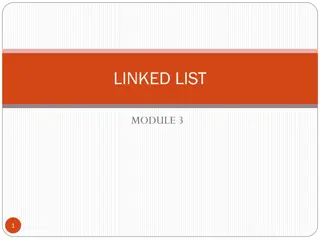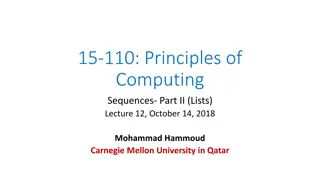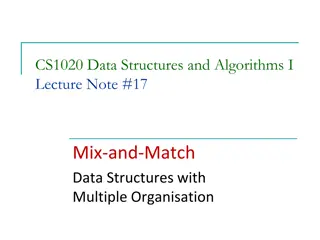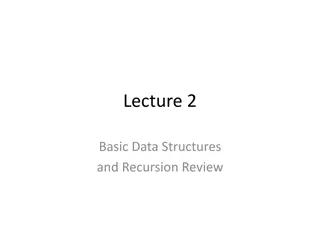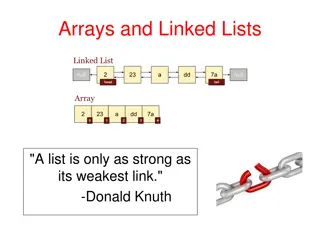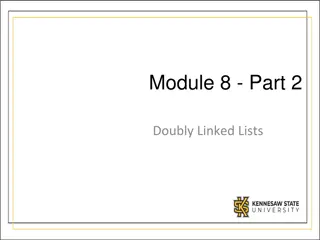
Doubly Linked Lists: Operations, Insertion, and Traversal
Explore the concept of doubly linked lists, their operations, and insertion techniques explained with helpful visual examples. Learn how to initialize, search, delete, and work with doubly linked lists efficiently.
Download Presentation

Please find below an Image/Link to download the presentation.
The content on the website is provided AS IS for your information and personal use only. It may not be sold, licensed, or shared on other websites without obtaining consent from the author. If you encounter any issues during the download, it is possible that the publisher has removed the file from their server.
You are allowed to download the files provided on this website for personal or commercial use, subject to the condition that they are used lawfully. All files are the property of their respective owners.
The content on the website is provided AS IS for your information and personal use only. It may not be sold, licensed, or shared on other websites without obtaining consent from the author.
E N D
Presentation Transcript
Doubly Linked Lists Linking in double direction
Doubly Linked Lists A doubly linked list is a linked list in which every node has a next pointer and a back pointer. A doubly linked list can be traversed in either direction. That is, we can traverse the list starting at the first node or, if a pointer to the last node is given, we can traverse the list starting at the last node.
Typical operations over Double LL The typical operations on a doubly linked list are: Initialize the list. Destroy the list. Determine whether the list is empty. Search the list for a given item. Retrieve the first element of the list. Retrieve the last element of the list. Insert an item in the list. Delete an item from the list. Find the length of the list. Print the list. Make a copy of the doubly linked list.
Insert a node Because we are inserting an item in a doubly linked list, the insertion of a node in the list requires the adjustment of two pointers in certain nodes. As before, we find the place where the new item is supposed to be inserted, create the node, store the new item, and adjust the link fields of the new node and other particular nodes in the list. There are four cases: Case 1: Insertion in an empty list Case 2: Insertion at the beginning of a nonempty list Case 3: Insertion at the end of a nonempty list Case 4: Insertion somewhere in a nonempty list Both Cases 1 and 2 require us to change the value of the pointer first. Cases3 and 4 are similar. After inserting an item, count is incremented by 1. Next, we show Case 4.
Insert a node Suppose that 20 is to be inserted in the list. After inserting 20, the resulting list is as shown in From Figure it follows that the next pointer of node 15, the back pointer of node 24, and both the next and back pointers of node 20 need to be adjusted.
if (first == NULL) //if the list is empty, newNode is //the only node { first = newNode; last = newNode; count++; } else { found = false; current = first; while (current != NULL && !found) //search the list if (current->info >= insertItem) found = true; else { trailCurrent = current; current = current->next; } template <class Type> void doublyLinkedList<Type>::inser t(const Type& insertItem) { nodeType<Type> *current; //pointer to traverse the list nodeType<Type> *trailCurrent; //pointer just before current nodeType<Type> *newNode; //pointer to create a node bool found; newNode = new nodeType<Type>; //create the node newNode->info = insertItem; //store the new item in the node newNode->next = NULL; newNode->back = NULL;
if (current == first) //insert newNode before first { first->back = newNode; newNode->next = first; first = newNode; count++; } else { //insert newNode between trailCurrent and current if (current != NULL) { trailCurrent->next = newNode; newNode->back = trailCurrent; newNode->next = current; current->back = newNode; } else { trailCurrent->next = newNode; newNode->back = trailCurrent; last = newNode; } count++; } //end else } //end else } //end insert
#include<iostream> using namespace std; void main() { char ch; do { char input; cout<<"Type 'a' to add node\n" <<"Type 'd' to display LL\n" <<"Type 'b' to display LL backward\n" <<"Type 's' to search element\n" <<"Type 'x' to delete node\n"; cin>> input; struct node { int data; node *next; node *back; }; void addnode(); void display(); void backward(); void search(); void delnode(); node *start=NULL, *temp1, *temp2, *temp3;
switch (input) { case 'a': addnode(); break; case 'd': display(); break; case 'b': backward(); break; case 's': search(); break; case 'x': delnode(); break; } cout<<"Do you want to process again (y/n)?\n"; cin>>ch; } while(ch != 'n'); system("pause"); }
void addnode() { char r; temp1 = new node; cout<<"Enter number to LL, please\n"; cin>>temp1->data; cout<<"Type 's' to add in start, 'e' to end\n"; cin>>r; switch (r) { case 's': if(start == NULL) { start=temp1; temp1->next=NULL; temp1->back=NULL; } else { temp2=start; temp1->next=temp2; temp1->back=NULL; start=temp1; temp2->back=temp1; } break;
case 'e': void display() { if(start == NULL) { start=temp1; temp1->next=NULL; temp1->back=NULL; } else { temp2=start; while(temp2->next !=NULL) temp2=temp2->next; temp2->next=temp1; temp1->back=temp2; temp1->next=NULL; } break; temp3=start; if(start == NULL) cout<<"LL is empty\n"; else while (temp3->next != NULL) { cout<<"Data stored "<<temp3->data<<" at "<<temp3<<endl; temp3=temp3->next; } cout<<"Data stored "<<temp3->data<<" at "<<temp3<<endl; } } }
void backward() { temp3=start; if(start == NULL) cout<<"LL is empty\n"; else while (temp3->next != NULL) { temp3=temp3->next; } while (temp3->back != NULL) { cout<<"Data stored "<<temp3->data<<" at "<<temp3<<endl; temp3=temp3->back; } cout<<"Data stored "<<temp3- >data<<" at "<<temp3<<endl; } void search() { int num; cout<<"Type number to search in LL\n"; cin>>num; temp1=start; while(temp1 != NULL) { if(temp1->data == num) { cout<<temp1->data<<" is stored in "<<temp1<<endl; } temp1=temp1->next; } }
void delnode() { char d; cout<<"Type 's' to delete from start, 'e' from end\n"; cin>>d; switch (d) { case 's': if(start == NULL) { cout<<"No node to delete\n"; } else { temp1=start; start=start->next; start->back=NULL; delete temp1; } break; case 'e': if(start == NULL) { cout<<"No node to delete\n"; } else { temp1=start; while(temp1->next != NULL ) { temp2=temp1; temp1=temp1->next; } delete temp1; temp2->next=NULL; } break; } }

